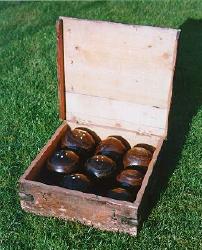
Images show antique set of wooden bowls from
|
|
History |
Bowls historians believe that the game developed from the Egyptians. One of their pastimes was to play skittles with round stones. This has been determined based on artefacts found in tombs dating circa 5,000 B.C. The sport spread across the world and took on a variety of forms, Bocce (Italian), Bolla (Saxon), Bolle (Danish), Boules (French) and Ula Miaka (Polynesian). The oldest Bowls green still played on is in Southampton, England where records show that the green has been in operation since 1299 A.D. There are other claims of greens being in use before that time, but these are, as yet, unsubstantiated

Images show antique set of wooden bowls from
|
Certainly the most famous story in lawn bowls is with Sir Frances Drake and the Spanish Armada. On July 18, 1588, Drake was involved in a game at Plymouth Hoe when he was notified that the Spanish Armada were approaching. His immortalised response was that "We still have time to finish the game and to thrash the Spaniards, too." He then proceeded to finish the match which he lost before embarking on the fight with the Armada which he won. Whether this famous story really took place has been heavily debated.
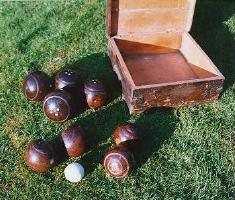 |
King Henry VIII was also a lawn bowler. However, he banned the game for those who were not wealthy or "well to do" because "Bowyers, Fletchers, Stringers and Arrowhead makers" were spending more time at recreational events such as bowls instead of practising their trade. Henry VIII requested that anybody who wished to keep a green pay a fee of 100 pounds. However, the green could only be used for private play and he forbade anyone to "play at any bowle or bowles in open space out of his own garden or orchard".
King James I issued a publication called "The Book of Sports" and, although he condemned football (soccer) and golf, encouraged the play of bowls. In 1845, the ban was lifted, and people were again allowed to play bowls and other games of skill.
The English Bowling Association was founded in 1903 and it is very well organised
sport which hosts numerous competitions from the club to the national level.
The sport is most popular in the South of England with thousands of devotees.
Because success doesn't require physical fitness, it is particularly favoured
by older folk but there are a lot of younger players, too. As with many English
sports, Lawn Bowls spread to the the British colonies from the 1600s onwards.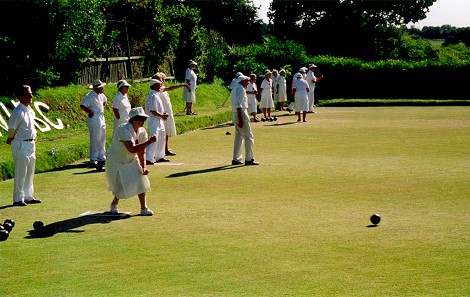 Lawn
Bowls was first played in North America in the early 1600's in the United States.
Records show that President George Washington played bowls on his estate.
In Canada, the sport was introduced around 1730 at Port Royal in Nova
Scotia. In Australia, bowls first was played in Sandy Bay, Tasmania in
1844. The game appeared in New Zealand sometime during the 30 years after
that. The World Bowling Board (WBB) is responsible for the standardisation
of rules across the world, and is charged with the task of encouraging the growth
of the game world-wide.
Lawn
Bowls was first played in North America in the early 1600's in the United States.
Records show that President George Washington played bowls on his estate.
In Canada, the sport was introduced around 1730 at Port Royal in Nova
Scotia. In Australia, bowls first was played in Sandy Bay, Tasmania in
1844. The game appeared in New Zealand sometime during the 30 years after
that. The World Bowling Board (WBB) is responsible for the standardisation
of rules across the world, and is charged with the task of encouraging the growth
of the game world-wide.

Lawn Bowls is usually played straight up and down a lawn. In singles, each player has four bowls called "woods" (although these days, 90% of bowls are made from a resin material) which are rolled alternately at a target ball called a Jack. For Doubles, it is three bowls each and for rinks or fours, it is just two. Each bowl is less rounded on one side which results in the bowl being "biased" in one direction due to the extra weight on one side. The bias of a correctly rolled bowl ensures that it follows a slightly curved path as it rolls which accentuates as the bowl comes to a halt. The Jack is a smaller white ball without a bias.
The sport of Lawn Bowls is the forerunner of Curling, a tremendously popular winter version played in northern countries (including Canada and Scotland) on ice. It isn't clear if the Scots or the Dutch invented the game; the first written records on it are from the 1600's. At one time the stones that slide across the ice were pieces of granite weighing up to 56kg. Gradually they evolved into plump stone discs with a handle protruding from the top surface. The target is a circle 32 metres from the thrower and the game is played by 2 teams of 4 players, each player sliding 2 stones per go. The slightly bizarre final aspect of the game is that each player is equipped with a genuine broom which is used to scrub the ice just ahead of the stone as it slides towards the target. The scrubbing warms the ice which creates a film of water that the stone slides over speeding it slightly. Skilful work with the broom will successfully deviate the direction of the stone or lengthen the distance it travels in such a way that it eventually comes to rest nearer to the target.....
 |
Crown Green Bowls is a game of arguably greater interest since it features an additional dimension. A Crown Green is a square lawn slightly higher in the middle than at the edges and play is conducted all over the lawn in any direction making for a great deal more variety than the flat green game.
The game has always been associated more with pubs and taverns than Lawn Green bowls and although it does not have the enormous popularity of the flat green game, it thrives very happily within its home base of the North of England and the North West Midlands.
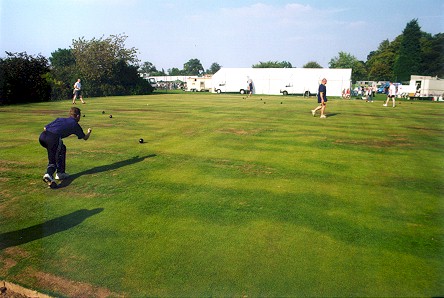 |
Play is almost always singles and each player bowls just two bowls each end.
The winner of each turn can play the jack in any direction and at any reasonable
distance within the lawn boundary which is a ditch. Some players are best
at bowling across the hump, others along the sloping side, some prefer short
distances, others long and so many additional tactical complexities are introduced
by the unusual lawn. Watching the multiple games occurring in all directions
at once across a crown green bowling lawn is an spectating experience worth
seeking out. Somehow, the individual games manage to intersect and cross
over each other without any adverse consequences!
Crown Green Bowls is a well organised sport arranged on a county basis. Individual clubs, often affiliated to pubs form teams that compete in "midweek" leagues that are grassroots of the sport and, at the next strata up, counties hold their own competitions. Crown Green Inter-County bowls matches date back to 1893 when Yorkshire and the combined county of Lancashire & Cheshire began playing friendly matches and this tradition has carried on until the present day, with the British Crown Green Bowls Association taking over the organisation of the competition in 1908. A complete history of this and other competitions can be found on the BCGBA site. In the year 2000, 15 county teams entered the competition. As can be seen from the following list, not all of the teams are, in fact, single counties and one team actually represents a country.....
N.Lancs & Fylde
|
Warwick & Worcester
|
Merseyside
|
As well as Wales, the sport is played in Scotland, Ireland and the Isle of Man. The first officially organised international happened in 1995 between Wales and England and the following year, the inaugural International tournament was staged in the County Association of North Lancs & Fylde. This competition took the four teams from England, combined Scotland/Ireland, Wales and the Isle of Man. The first competition was won by England, while in the 1999 tournament, the combined Scottish/Irish team were victorious.
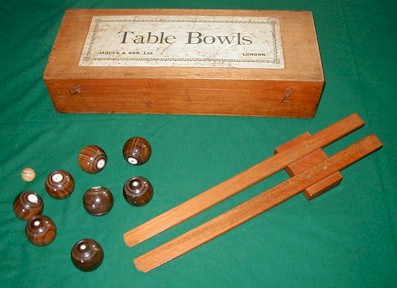 Other
variants such as carpet bowls and indoor bowls have been popular at one time
or another. The best known indoor version of Bowls is a pub game that
appeared around the district of Carlisle called Table Bowls. In this game
a miniature set of bowls and jack are played on a standard 12 x 6 feet Billiards
or Snooker table. The bowls and jack are rolled down a wooden chute which
is placed slanting on the table edge with one end on the table. No impetus
is allowed to be given to the bowls - it is purely the angle of the chute and
how far up it the bowl starts that determines its final position.
Other
variants such as carpet bowls and indoor bowls have been popular at one time
or another. The best known indoor version of Bowls is a pub game that
appeared around the district of Carlisle called Table Bowls. In this game
a miniature set of bowls and jack are played on a standard 12 x 6 feet Billiards
or Snooker table. The bowls and jack are rolled down a wooden chute which
is placed slanting on the table edge with one end on the table. No impetus
is allowed to be given to the bowls - it is purely the angle of the chute and
how far up it the bowl starts that determines its final position.
The author recently heard from two players in Queensland, Australia where there
are apparently several locations playing Table Bowls - see the Pubs section
below for further details. In fact, they have a number of competitions including
a "World Championship" although they are having second thoughts about
the title having now learned of the English game!
 When winter
comes around, Bowls like many outdoor games, become less easy to play. So indoor
variations of the game have come into existence. One popular variety is called
simply Indoor Bowls and is essentially Lawn Bowls played on an indoor surface
with the majority of the rules consistent with that game. However, another variant
called Short Mat Bowls, with characteristics all of its own, has a really big
following all over Britain and Ireland. Like many pub games, it is really a
miniaturised version of the outdoor game to enable it to be played more easily
indoors. It is played on a mat measuring 40-45 x 6 feet with full-size bowls,
the mat being easily rolled up and put away for convenience. There is a ditch
but this is simply an area marked at the end of the mat and to compensate for
the shorter distance an intimidating block is placed in the centre of the mat.
This makes it impossible for a bowler to aim a fast straight bowl at the jack
area - all bowls must use the bias to curl around the block o their target.
When winter
comes around, Bowls like many outdoor games, become less easy to play. So indoor
variations of the game have come into existence. One popular variety is called
simply Indoor Bowls and is essentially Lawn Bowls played on an indoor surface
with the majority of the rules consistent with that game. However, another variant
called Short Mat Bowls, with characteristics all of its own, has a really big
following all over Britain and Ireland. Like many pub games, it is really a
miniaturised version of the outdoor game to enable it to be played more easily
indoors. It is played on a mat measuring 40-45 x 6 feet with full-size bowls,
the mat being easily rolled up and put away for convenience. There is a ditch
but this is simply an area marked at the end of the mat and to compensate for
the shorter distance an intimidating block is placed in the centre of the mat.
This makes it impossible for a bowler to aim a fast straight bowl at the jack
area - all bowls must use the bias to curl around the block o their target.
The short mat bowls game was first played in South Wales by two South Africans
who came to work in the area. They had played bowls outdoors in South Africa
and, perhaps due to the poor climate and the long close season in this country,
they began to play a simulation of the outdoor game on a strip of carpet in
a church hall. Some time later, they moved to Northern Ireland and took the
new game with them. Rules and conditions of play were drawn up and the game
soon became well established in the Province. It was introduced into England
by Irish expatriates, but development was slow until the 1980's when its potential
as a low cost sport for people of all ages was realised. The English Short Mat
Bowling Association (ESMBA) was formed in 1984, and is now the governing body
of the sport in England. Thanks to the Cornwall
County Short Mat Bowling Association for this information.CORNWALL COUNTY
SHORT MAT BOWLING ASSOCIATION
Rolle Bolle was developed by Belgians, around the time of the Reformation, somewhat a cross between horseshoes and bowlings.Ó It is played on hard packed sand, with stakes set 30 feet apart.Ó Teams try to roll the beveled, hard rubber Bolle so that it stays closest to the stake.
http://freepages.genealogy.rootsweb.com/~vangampleare/RolleBolle.htm
http://www.starpoint.net/~darco/rolle.htm
Masters Games sells Table Bowls.
History of Lawn Bowls
The English Bowls Association
English Indoor Bowls Association
A-Z Lawn Bowls
Australia's First Lawn
Bowls Site
The Unofficial Lawn Bowls Page
from Canada
The American Lawn Bowls Association
The official British Crown Green Bowling Association
website has an interesting competition history and a schedule of events.
Isle of Man Crown Green Bowling
Association
Wales Crown Bowls Association
Short Mat International Magazine
Short Mat Bowls Master List
On the Mat
English Short Mat Bowling
Association
If you want to submit a pub to this list, please just e-mail me:
The Birches Inn, Healey, near Rochdale, Greater Manchester
The Wynnstay Arms, Oswestry, Shropshire
The Elephant and Castle, Shawbury, Shropshire
The Holly Bush, Stockton Brook, Stoke-on-Trent, Staffordshire
The King's Arms, Meir, Stafordshire
The Railway Station, Congleton, Cheshire
Olton Tavern, Solihull,
West Midlands (submitted David Hosgood, April 2000)
Ercall Magna BC, Cleveland Arms at High Ercall , Nr Telford in Shropshire. (submitted
Steve Davies, July 2000)
The Tamar, Wigan Road, Leigh, Lancashire (submitted Steve Reynolds, October
2000)
The Ayr Anzac Memorial Club, Ayr, Queensland, Australia (submitted Graham Berlin and Peter Doig, April 2000)
East Birmingham Mid Week League
Ward End and Yardley League
Shrewsbury league (submitted Steve Davies, July 2000)
![]()
| The Online Guide to Traditional Games Home | Copyright ķ 1997-2001 by AGames. |